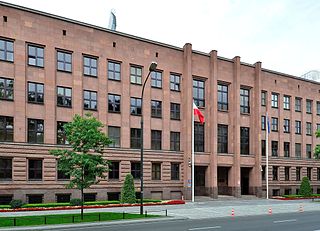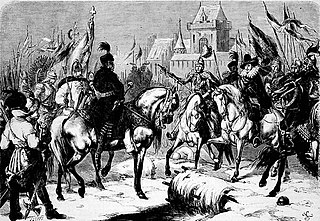
Napoleon Bonaparte, later known by his regnal name Napoleon I, was a French military officer and statesman who rose to prominence during the French Revolution and led a series of successful campaigns across Europe during the French Revolutionary and Napoleonic Wars from 1796 to 1815. He was the leader of the French Republic as First Consul from 1799 to 1804, then of the French Empire as Emperor of the French from 1804 to 1814, and briefly again in 1815.

Zamość is a historical city in southeastern Poland. It is situated in the southern part of Lublin Voivodeship, about 90 km (56 mi) from Lublin, 247 km (153 mi) from Warsaw. In 2021, the population of Zamość was 62,021.

Gabriel Józef Narutowicz was a Polish professor of hydroelectric engineering and politician who served as the first President of Poland from 11 December 1922 until his assassination on 16 December, five days after assuming office. He previously served as the Minister of Public Works from 1920 to 1922 and briefly as Minister of Foreign Affairs in 1922. A renowned engineer and politically independent, Narutowicz was the first elected head of state following Poland's regained sovereignty from partitioning powers.

Jan Sariusz Zamoyski was a Polish nobleman, magnate, statesman and the 1st ordynat of Zamość. He served as the Royal Secretary from 1565, Deputy Chancellor from 1576, Grand Chancellor of the Crown from 1578, and Great Hetman of the Crown from 1581.

Stanisław Wawrzyniec Staszic was a leading figure in the Polish Enlightenment: a Catholic priest, philosopher, geologist, writer, poet, translator and statesman. A physiocrat, monist, pan-Slavist and laissez-fairist, he supported many reforms in Poland. He is particularly remembered for his political writings during the "Great (Four-Year) Sejm" (1788–92) and for his large support towards the Constitution of 3 May 1791, adopted by that Sejm.

The Czartoryski coat of arms is a Polish–Lithuanian coat of arms, a variant of the Pogoń Litewska arms. It has been used by the Gediminid Czartoryski family.

The Ministry of Foreign Affairs is the Polish government department tasked with maintaining Poland's international relations and coordinating its participation in international and regional supra-national political organisations such as the European Union and United Nations. The head of the ministry holds a place in the Council of Ministers.

Marie Casimire Louise de La Grange d'Arquien, known also by the diminutive form "Marysieńka", was a French noblewoman who became the queen consort of Poland and grand duchess consort of Lithuania from 1674 to 1696 by her marriage to King and Grand Duke John III Sobieski of the Polish–Lithuanian Commonwealth. She had great influence upon the affairs of state with the approval of her spouse, and acted in effect as regent during his absence.

Konstanty Kalinowski, or Wincenty Konstanty Kalinowski, was a Polish writer,journalist, lawyer and revolutionary. He was one of the leaders of 1863 January Uprising on the lands of the former Polish–Lithuanian Commonwealth. He is considered as a national hero in present-day Poland, Lithuania and Belarus. Particularly in Belarus, Kalinowski is revered as Father of the Nation and icon of Belarusian nationalism.

Konstanty Wasyl Ostrogski was a Ruthenian Orthodox magnate of the Polish–Lithuanian Commonwealth, a prince, starost of Volodymyr, marshal of Volhynia and voivode of the Kiev Voivodeship. Ostrogski refused to help False Dmitriy I and supported Jan Zamoyski.

The House of Czartoryski is a Polish princely family of Lithuanian-Ruthenian origin, also known as the Familia. The family, which derived their kin from the Gediminids dynasty, by the mid-17th century had split into two branches, based in the Klevan Castle and the Korets Castle, respectively. They used the Czartoryski coat of arms and were a noble family of the Polish–Lithuanian Commonwealth in the 18th century.

The House of Zamoyski is an important Polish noble (szlachta) family belonging to the category of Polish magnates. They used the Jelita coat of arms. The surname "Zamoyski" literally means "of/from Zamość" and reflects the fact that the family originally were lords of Zamość, according to a tradition of surnames of Polish nobility. The family was influential in Polish politics for several centuries, and its members held various official titles, including those of Count and Countess.

The Battle of Byczyna, also known as the Battle of Pitschen, was the deciding battle of the 1587–1588 War of the Polish Succession, which erupted after two rival candidates were elected to the Polish throne. The two opposing sides had forces nearly evenly matched, with armies about 6,000 strong, roughly half infantry and half cavalry. The battle was an overwhelming victory for the Polish-Swedish faction, led by the Swedish-born king-elect Sigismund III Vasa, over the army of his rival to the throne, Maximilian III, Archduke of Austria.

Kozłówka Palace is a large rococo and neoclassical palace complex of the Zamoyski family in Kozłówka, Lubartów County, Lublin Voivodeship in eastern Poland.
Leandro Marconi (1834–1919) was a Polish architect, active mainly in Warsaw. His father was Enrico Marconi, also a famed architect associated with that city, while his cousin was Leonard Marconi, a sculptor.

The War of the Polish Succession or the Habsburg-Polish War took place from 1587 to 1588 over the election of the successor to the King of Poland and Grand Duke of Lithuania Stephen Báthory. The war was fought between factions of Sigismund III Vasa and Maximilian III, with Sigismund eventually being crowned King of Poland and Grand Duke of Lithuania. Two major battles of this conflict included the Siege of Kraków, in which Maximilian III failed to capture the capital of the Commonwealth, and the Battle of Byczyna, in which Maximilian was forced to surrender. Sigismund's victory was significantly the doing of Chancellor and Hetman Jan Zamoyski, who stood behind both the political intrigue and the military victories of this conflict.

Stanisław Egbert Koźmian was a Polish writer, poet and translator. He is now best known for translating the works of William Shakespeare into Polish.

The Zamoyski family entail was one of the first and largest fee tails in the Polish–Lithuanian Commonwealth. It was owned by the Zamoyski family, the richest aristocratic family in Poland. It was established upon the request of Crown Hetman Jan Zamoyski, on 8 July 1589. The fee existed until the end of World War II, when it was abolished by the communist government of the People's Republic of Poland, which in 1944 initiated an agricultural reform.

K. Rudzki i S-ka was a Polish engineering and machinery company. Founded in Warsaw in 1858 as an iron foundry by a shipbuilding magnate Andrzej Artur Zamoyski and led by Konstanty Rudzki, it soon expanded into machinery, steel and engineering. By the end of the 19th century the company, with its seat in Warsaw and a large factory in Mińsk Mazowiecki, had become one of the largest and most experienced bridge construction contractors in Central and Eastern Europe, with roughly 20% of bridges constructed in the Russian Empire bearing the logo of K. Rudzki. After World War I the company declined and ceased its machinery production arm, but continued on as an engineering and construction business. It was nationalised and liquidated after World War II.

The Konstanty Zamoyski Palace is a historic building on ulica Foksal in Warsaw, Poland.



















